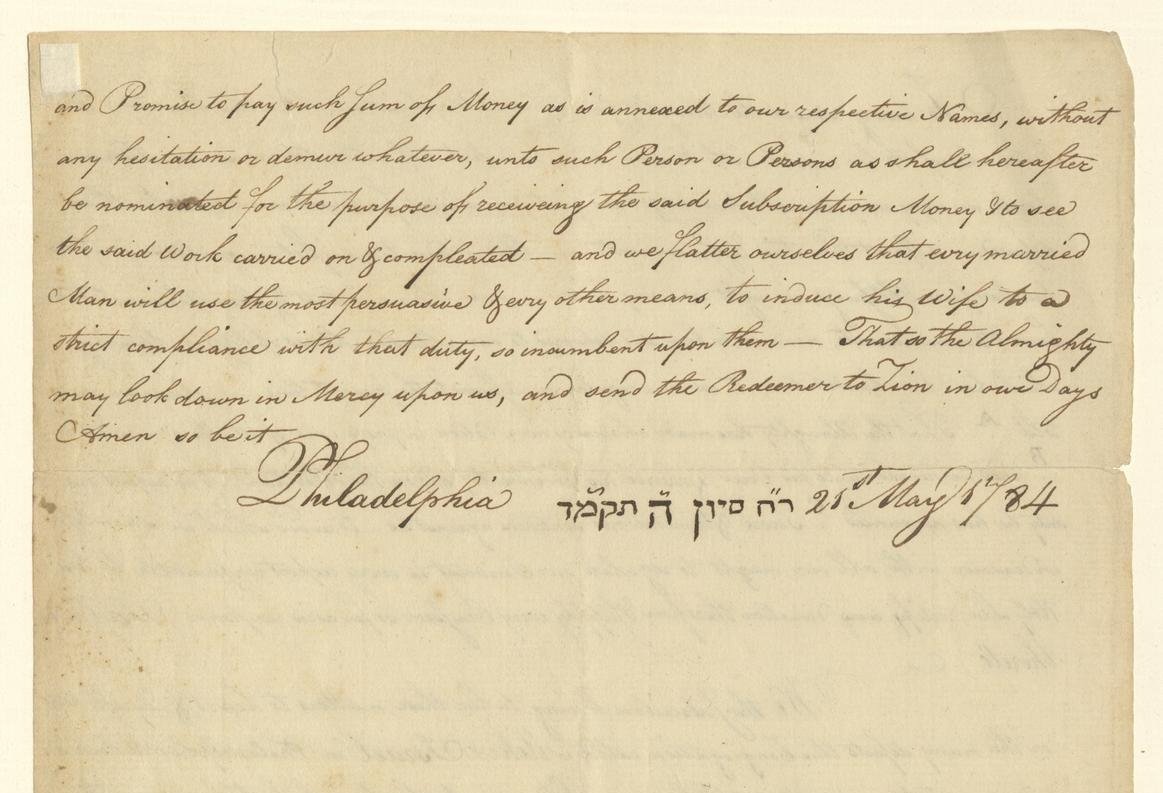Mikveh Israel's History
Congregation Mikveh Israel, known as the "Synagogue of the American Revolution," is the oldest formal congregation in Philadelphia, Pennsylvania and the oldest continuous synagogue in the United States.
1740 Spruce Street Cemetery between 8th & 9th Streets
In 1740, Nathan Levy applied to Thomas Penn, Royal Proprietor of Pennsylvania, for a plot to bury his child in accordance with Jewish ritual. It became a Jewish communal cemetery, the first evidence of Jewish communal life in Philadelphia. Mikveh Israel dates its beginning from the establishment of the cemetery.
Early Minyan
Religious services were first held in private homes, including that of Nathan Levy. Later, rented quarters were obtained, first on Sterling Alley (presently Orianna Street ) then around the corner on Cherry Street. A commemorative marker stands on Cherry Street, between Arch and Race, Third and Fourth Streets.
1765 Non-Importation Resolutions
To pay for the French and Indian War, the British imposed a stamp tax on her American colonies. In 1765, the Non-Importation Resolutions were drawn up with signatures of many citizens who agreed "not to have any goods shipped from Great Britain until the repeal of the Stamp Act." Signers include the following members of Mikveh Israel: the merchants Mathias Bush, Moses Mordecai and Barnard Gratz.
1775-1783 Synagogue of the Revolution
During the War of Independence, Jews from New York, Richmond, Charleston, Savannah, Lancaster and Easton fled to Philadelphia seeking refuge from the British. In 1780, Rev. Gershom Mendes Seixas, Hazan (Minister) of Congregation Shearith Israel in New York, came to Philadelphia and became its religious leader. During his tenure, he was instrumental in establishing the form of prayer and organizational structure in the Spanish-Portuguese tradition which remain today.
1782 First Building
An increase in membership as well as financial help from those who sought refuge in Philadelphia, allowed the congregation to establish a permanent religious home. A lot was purchased on Cherry Alley. A carpenter and bricklayer were hired to build a two-story brick building, hardly distinguishable by style from those around it. Space on the lot was approved for a home for the Hazan, a school and a mikvah, in addition to an oven for Matza baking for Passover. Close by were the Old Reformed Church of the United Church of Christ and the Zion Evangelical Lutheran Church. A commemorative marker stands at that place.
1783 Society for the Relief of Destitute Strangers (Ezrath Orechim)
The first Jewish charitable organization in the city was established by Mikveh Israel. Officers: Jacob I. Cohen, president; Isaiah Bush, secretary; Haym Salomon, treasurer.
1783 Protest of Religious Test Oath
On December 23, 1783, a committee including Rev. Gershom Mendes Seixas, Simon Nathan Parnas/President, Asher Myers, Barnard Gratz and Haym Salomon, addressed the Pennsylvania Council of Censors to protest the declaration required of each member of the Pennsylvania Assembly that the Hebrew and Christian Scriptures were given by divine inspiration. This oath deprived Jews of the right to be representatives. The protest was not accepted but influenced the United States Constitution which does not provide a religious oath for holding of office.
Donations for building of the new Synagogue, 1782
Petition to build a mikveh, 1784
1788 Subscription List
Members of the congregation, including Rev. Seixas , returned to New York , Charleston and other locations when British occupation ceased. Left with debt incurred by synagogue construction loans, a subscription list was addressed to "worthy fellow Citizens of every religious Denomination." Among the contributors were Benjamin Franklin; David Rittenhouse, astronomer; Hilary Baker, city councilman (later mayor); Thomas McKean, a signer of the Declaration of Independence, Chief Justice and later Governor of Pennsylvania; William Bradford, Attorney-General of Pennsylvania; and Thomas Fitzsimmons, a drafter of the U.S. Constitution, first president of the Philadelphia Chamber of Commerce and the city's leading Catholic layman.
1790 Josephson & Washington Letters
On December 13, 1790, Manuel Josephson, Parnas/President of Mikveh Israel , personally presented a letter of homage and congratulations to President George Washington on behalf of "the Hebrew Congregations in the Cities of Philadelphia, New York, Charleston and Richmond" for his "elevation to the chair of the Federal Government." Facsimiles of that letter and the reply of Washington can be seen in the lobby.
1825 Second Building
When the 1782 building became inadequate, the Board of Adjuntos (Managers) voted to build a larger synagogue on the same site. William Strickland, leading architect, designed a structure of white stone from the "Falls of the Schuylkill," one of the most dignified buildings of its kind in the country.
1840 Protest of the Damascus Blood-Libel
On August 27, 1840, a public protest was held at Mikveh Israel of this international incident in which seven Jewish men were tortured and 63 Jewish children held hostage. Several influential Christian ministers spoke at the meeting. A committee consisting of Rev. Isaac Leeser, John Moss, David Samuel, J. L. Moss and L. J. Levy sent a letter of protest to President James K. Polk. They received a reply from Secretary of State John Forsyth on September 2, 1840.
1859 Third Building
Prior to the Civil War (1861-1865) as the Jewish population grew and prospered, an elegant building was constructed on 7th Street, north of Arch. It was designed by John McArthur, Jr. (later, architect of City Hall of Philadelphia).




